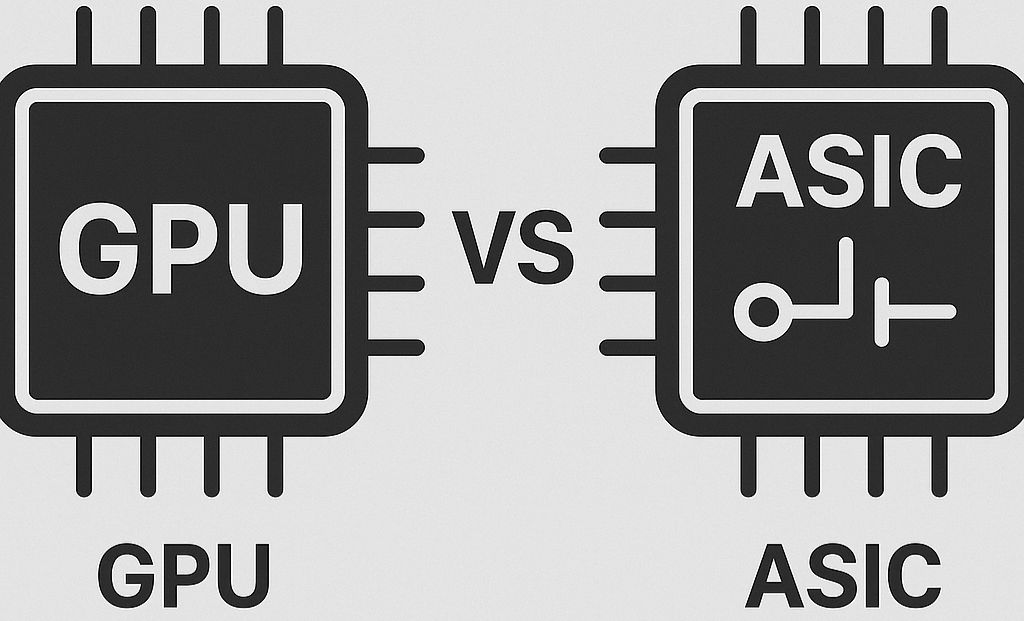GPU vs ASIC Mining: What’s the Difference?

To profitably mine cryptocurrencies, you need to differentiate between GPU vs ASIC Miner.
While miners face a critical decision that can make or break their profitability: choosing between GPU and ASIC mining hardware. Ultimately, this choice impacts everything from initial investment costs to long-term sustainability in the competitive world of crypto mining.
Therefore, understanding the fundamental differences between these technologies is essential for anyone serious about mining. While each approach offers distinct advantages and limitations, these differences directly affect your mining operation’s success. Moreover, making an informed choice can lead to more efficient and profitable outcomes.
What Makes ASIC Mining So Powerful
ASIC (Application-Specific Integrated Circuit) miners are the Formula 1 cars of cryptocurrency mining. These specialized machines do one thing exceptionally well: mine specific cryptocurrencies at blazing speeds.
However, ASIC miners achieve hash rates measured in terahashes per second (TH/s). Compare this to GPUs that typically max out at hundreds of megahashes per second (MH/s). This massive performance gap translates directly into mining rewards.
The efficiency advantage extends beyond raw speed. ASICs consume significantly less power per unit of computational work. Modern ASIC models like the Antminer S21 can maintain profitable operations even when Bitcoin prices dip to $37,000. Less efficient models struggle to break even at these price levels.
Setting up an ASIC miner requires minimal technical knowledge. Most units arrive ready to mine straight out of the box. Plug in the power, connect to the internet, and start earning cryptocurrency within minutes.
The Versatility Advantage of GPU Mining
Graphics Processing Units, on the other hand, bring flexibility that ASICs simply cannot match. Initially, designed for rendering video game graphics, GPUs excel at parallel processing tasks. As a result, this makes them ideal for mining various cryptocurrencies.
In practice, GPU miners can switch between different coins based on profitability. For example, mine Ethereum Classic today, switch to Ravencoin tomorrow, and pivot to Ergo next week. Consequently, this adaptability provides crucial protection against market volatility.
The resale value of GPUs remains strong due to their multiple use cases. Gamers, video editors, and AI researchers all compete for high-end graphics cards. When mining becomes unprofitable, you can sell your GPUs to recover significant portions of your investment.
Building a GPU mining rig teaches valuable technical skills. Miners learn hardware assembly, software optimization, and thermal management. These skills transfer to other technology fields and can open new career opportunities. You may also see our top Cryptocurrency Mining software.
GPU vs ASIC Mining: What’s the Difference?
| Aspect | GPU Mining | ASIC Mining |
|---|---|---|
| Full Name | Graphics Processing Unit | Application-Specific Integrated Circuit |
| Purpose | General-purpose, used for gaming and mining | Built solely for mining specific algorithms |
| Flexibility | Highly versatile – can mine many coins | Limited – designed for one or few specific coins |
| Hash Rate (Performance) | Moderate to high (varies by GPU model) | Very high – optimized for maximum efficiency |
| Power Efficiency | Less efficient compared to ASICs | Highly power-efficient for specific tasks |
| Cost | Lower upfront cost; available consumer hardware | Higher initial cost; specialized hardware |
| Availability | Widely available and easier to source | Often scarce or sold out quickly |
| Lifespan | Longer (can be repurposed after mining) | Shorter (becomes obsolete quickly) |
| Noise & Heat | Moderate – varies by setup | High – generates significant noise and heat |
| Maintenance | Easier to maintain and replace parts | Harder to repair – usually replaced if broken |
| Resale Value | Higher – can be used for gaming or resale | Lower – limited use outside mining |
| Best Use Case | Hobbyist or multi-coin miners | Industrial-scale or focused single-coin mining |
Critical Limitations You Must Consider
ASIC miners face obsolescence risk that can devastate your investment. When new, more efficient models launch, older ASICs quickly become unprofitable paperweights. The specialized nature means zero alternative uses exist.
The high upfront cost of ASIC miners creates a significant barrier to entry. Top-tier Bitcoin ASICs cost thousands of dollars. Market timing becomes crucial since units ordered during bull markets might arrive during bear markets.
GPU mining suffers from inferior energy efficiency compared to ASICs. Multiple graphics cards generate substantial heat and consume considerable electricity. Cooling solutions add complexity and ongoing maintenance requirements.
Space requirements for GPU rigs exceed those of compact ASIC units. A six-GPU mining rig needs proper ventilation, sturdy mounting, and adequate power distribution. Apartment miners often struggle with these physical constraints.
GPU vs ASIC Mining Profitability: Making the Right Choice Before SetUp
Your mining goals determine the optimal hardware choice. Consider these key factors before investing:
Choose ASIC mining when: – Maximum efficiency matters most to your operation – You’re committed to mining one specific cryptocurrency long-term – Rapid return on investment takes priority over flexibility – Technical complexity intimidates you
Select GPU mining when: – Flexibility to switch between cryptocurrencies appeals to you – Lower initial investment fits your budget better – Learning technical skills interests you – Resale value provides important downside protection
The Future of Cryptocurrency Mining Hardware
The mining landscape continues evolving rapidly. Ethereum’s transition to Proof of Stake eliminated GPU mining’s most profitable option. This shift forced many GPU miners to explore alternative cryptocurrencies or exit mining entirely.
ASIC manufacturers push efficiency boundaries with each new generation. Mining difficulty adjustments and halving events constantly reshape profitability calculations. Successful miners stay informed about hardware developments and market conditions.
Energy costs increasingly determine mining viability in different regions. Miners migrate operations to areas with cheap electricity and favorable regulations. Access to affordable power often matters more than hardware choice.
The secondary market for mining hardware provides opportunities for budget-conscious miners. Used GPUs from gaming enthusiasts offer entry points for beginners. Older ASIC models can remain profitable with sufficiently low electricity costs.
The GPU versus ASIC decision ultimately depends on your specific circumstances. Both technologies serve important roles in the cryptocurrency ecosystem. Smart miners evaluate their resources, goals, and risk tolerance before committing to either path. Success in mining requires continuous adaptation as technology and markets evolve.

